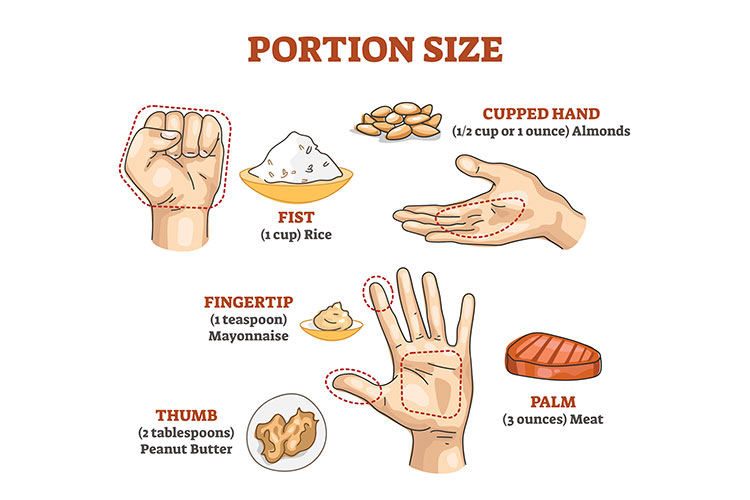Join Our eNewsletter!
Subscribe to our monthly newsletter to receive encouraging advice to help you lead a healthy lifestyle.

Teaching Children to Eat Healthy Starts with Portion Control
By Ankita Trivedi, MD, FAAP
Good nutrition promotes a healthy lifestyle and prevents many illnesses. A balanced diet is one that includes a variety of different foods in healthy proportions.
Eating habits in childhood lay the foundation for balanced nutrition throughout life. A few ways to encourage healthy eating habits in children are:
- Offer a wide variety of age-appropriate food consistently. It may take up to 10 - 15 exposures before kids will try a new food.
- Set a meal schedule. Limit grazing between meals so that kids can come to the meal table hungry and ready to eat.
- Make meals enjoyable. When possible, eat together as a family and keep the conversation light.
- Do not eat in front of a TV or other screens. This can often lead to inadvertent overeating.
- Involve kids in grocery shopping and meal prep so they can get "behind the scenes" as well.
Parents have the crucial responsibility to decide what, where, and when food is provided. Departments of Agriculture (USDA) and Health and Human Services (HHS) publish the "Dietary Guidelines for Americans" that provide insight into what constitutes good nutrition. These guidelines are a great tool to help parents decide what foods to serve. They also provide an overall sense of understanding of what age-appropriate portion sizes look like.
However, it's important to let the child decide for themselves if they want to eat and how much they want to eat. Allowing kids to make this decision on their own has several benefits:
- It empowers them to take control of their health at an early age.
- It teaches them to listen to their hunger and fullness cues and practice portion control.
- It avoids the negative emotions that arise from the pressure to "clean the plate" or try a new food.
It's also important to speak with your pediatrician if you notice that your child is extremely averse to trying new foods, persistently refuses an entire food group, or is gaining weight too slowly or too quickly.
How large your child's portions should be depends on their age; although if they're taller than other kids their age or are especially active, they may need to eat more than the recommended amount. Talk to your pediatrician if you're not sure how much your child should eat. For most children, the recommended daily guidelines below are a good place to start.
For every person, no matter the age, a balanced plate according to the U.S. Department of Agriculture looks like this:
- Half of the plate should be produced (fruits and veggies).
- A quarter of the plate should be lean protein.
- A quarter of the plate should be grains or starch.
- Include a small side of dairy, such as a piece of cheese or glass of milk.
Daily Recommended Servings by Age
Vegetables
- Age 12 – 23 months: 2/3 to 1 cup per day
- Age 2 – 4 years: 1 to 2 cups per day
- Age 5 – 8 years: 1-½ to 2-½ cups per day
- Age 9 – 13 years: 1-½ to 3 cups per day for girls; 2 to 3-½ cups per day for boys
- Age 14 – 18 years: 2-½ to 3 cups per day for girls; 2-½ to 4 cups per day for boys
Fruits
- Age 12 – 23 months: ½ cup to 1 cup per day
- Age 2 – 4 years: 1 cup to 1-½ cups per day
- Age 5 – 8 years: 1 cup to 2 cups per day
- Age 9 – 13 years: 1-½ cups to 2 cups per day
- Age 14 – 18 years: 1-½ cups to 2 cups per day
Lean Protein
- Age 12 - 23 months: 2 oz per day
- Age 2 - 4 years: 2 oz to 5 oz per day
- Age 5 - 8 years: 3 oz to 5 ½ oz per day
- Age 9 - 13 years: 4 oz to 6 oz per day for girls; 5 oz to 6-½ oz per day for boys
- Age 14 - 18 years: 5 oz to 6 ½ oz per day for girls; 5-½ oz to 7 oz per day for boys
Grains
- Age 12 – 23 months: 1-¾ oz to 3 oz per day
- Age 2 – 4 years: 3 oz to 5 oz per day
- Age 5 – 8 years: 4 oz to 6 oz per day
- Age 9 – 13 years: 5 oz to 7 oz per day for girls; 5 oz to 9 oz per day for boys
- Age 14 – 18 years: 5 oz to 8 oz per day for girls; 6 oz to 10 oz per day for boys
Dairy
- Age 12 – 23 months: 1-2/3 cups to 2 cups per day
- Age 2 – 4 years: 2 cups to 2-½ cups per day
- Age 5 – 8 years: 2-½ cups per day
- Age 9 – 13 years: 3 cups per day
- Age 14 – 18 years: 3 cups per day
To make it easier to visualize portion sizes, you can use charts such as this one:

A Note About Sugar
Most children have a built-in preference for sweetness. Kids who obtain more than 10% of their daily calories from added sugars are more likely to have abnormal cholesterol levels. They are also at an increased risk of developing Type 2 diabetes. The American Academy of Pediatrics (AAP) recommends that children under 2 years old not consume any added sugar at all, and children over 2 years old shouldn’t have more than 25 grams of added sugar per day.
Some ways to moderate sugar consumption are:
- Get in the habit of reading nutrition labels. Check for the "added sugar" line on the label.
- Cut down on beverages that contain "added sugar" such as soda, sweet teas, sports drinks, etc.
- Swap juice for whole fruit. The AAP recommends no more than 4 ounces of 100% fruit juice a day for children ages 1 through 3 years, 4 to 6 ounces for children ages 4 through 6, and 8 ounces for children ages 7 through 14. Don't give fruit juice to infants under 1 year old.


